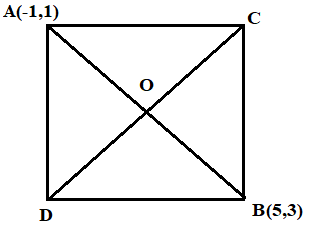
\[{\rm{A}}( - 1,1),{\rm{B}}(5,3)\] are opposite vertices of a square in \[xy\] -plane. The equation of the other diagonal (not passing through (\[A,B\]) of the square is given by
А. \[x - 3y + 4 = 0\]
B. \[2x - y + 3 = 0\]
C. \[y + 3x - 8 = 0\]
D. \[x + 2y - 1 = 0\]
Answer
217.2k+ views
Hint: In this case, the diagonals of the square \[AB\] and \[CD\] intersect at the point O. We have to determine the equation of diagonal \[CD\] and we also know that the diagonals of a square cross perpendicularly. As a result, AB is perpendicular to CD, and O is the intersection of AB and CD.
Formula Used: If the two line’s slopes are perpendicular, then we can use the formula
\[{{\rm{m}}_{\rm{1}}}{\rm{ x }}{{\rm{m}}_{\rm{2}}}{\rm{ = - 1}}\]
Complete step by step solution: We have been given that \[A\left( { - 1,{\rm{ }}1} \right)\] and \[B\left( {5,{\rm{ }}3} \right)\] are the opposite vertices of the square \[ACBD\] as seen in the below diagram

From the above diagram, it is understood that point O's coordinates are given by
\[ \Rightarrow \left( {\dfrac{{ - 1 + 5}}{2},\dfrac{{1 + 3}}{2}} \right)\]
Now, let us add the numerators, we get
\[ = \left( {\dfrac{4}{2},\dfrac{4}{2}} \right)\]
On simplifying the above, we obtain
\[ = \left( {2,2} \right)\]
The diagonal AB’s slope is given as,
\[m = \left( {\dfrac{{3 - 1}}{{5 - ( - 1)}}} \right)\]
Now, we have to simplify the denominator and numerator, we get
\[ = \dfrac{2}{6}\]
On further simplification, we get
\[ = \dfrac{1}{3}\]
We know that the product of the two perpendicular lines' slopes is -1.
As a result, the diagonal CD (m')’s slope is computed as follows:
\[m' \times m = - 1\]
On substituting the values, we get
\[ \Rightarrow m' \times \left( {\dfrac{1}{3}} \right) = - 1\]
Now, we have to simplify the above equation, we get
\[m' = - 3\]
As a result, the equation for the diagonal CD with slope \[m'\] and passing through the point \[O\left( {2,{\rm{ }}2} \right)\] is
\[y - 2 = m'(x - 2)\]
Now, we have to substitute the corresponding values to the formula, we get
\[ \Rightarrow y - 2 = - 3(x - 2)\]
Multiply the term outside with the terms inside the parentheses,
\[ \Rightarrow y - 2 = - 3x + 6\]
On simplification, we get
\[ \Rightarrow 3x + y = 8\]
Therefore, the equation of the other diagonal (not passing through (\[A,B\]) of the square is given by
\[y + 3x - 8 = 0\]
Option ‘C’ is correct
Note: Students fail to consider both positive and negative instances, resulting in only one equation, which might lead to an incorrect response. As a result, they must exercise caution.
Formula Used: If the two line’s slopes are perpendicular, then we can use the formula
\[{{\rm{m}}_{\rm{1}}}{\rm{ x }}{{\rm{m}}_{\rm{2}}}{\rm{ = - 1}}\]
Complete step by step solution: We have been given that \[A\left( { - 1,{\rm{ }}1} \right)\] and \[B\left( {5,{\rm{ }}3} \right)\] are the opposite vertices of the square \[ACBD\] as seen in the below diagram

From the above diagram, it is understood that point O's coordinates are given by
\[ \Rightarrow \left( {\dfrac{{ - 1 + 5}}{2},\dfrac{{1 + 3}}{2}} \right)\]
Now, let us add the numerators, we get
\[ = \left( {\dfrac{4}{2},\dfrac{4}{2}} \right)\]
On simplifying the above, we obtain
\[ = \left( {2,2} \right)\]
The diagonal AB’s slope is given as,
\[m = \left( {\dfrac{{3 - 1}}{{5 - ( - 1)}}} \right)\]
Now, we have to simplify the denominator and numerator, we get
\[ = \dfrac{2}{6}\]
On further simplification, we get
\[ = \dfrac{1}{3}\]
We know that the product of the two perpendicular lines' slopes is -1.
As a result, the diagonal CD (m')’s slope is computed as follows:
\[m' \times m = - 1\]
On substituting the values, we get
\[ \Rightarrow m' \times \left( {\dfrac{1}{3}} \right) = - 1\]
Now, we have to simplify the above equation, we get
\[m' = - 3\]
As a result, the equation for the diagonal CD with slope \[m'\] and passing through the point \[O\left( {2,{\rm{ }}2} \right)\] is
\[y - 2 = m'(x - 2)\]
Now, we have to substitute the corresponding values to the formula, we get
\[ \Rightarrow y - 2 = - 3(x - 2)\]
Multiply the term outside with the terms inside the parentheses,
\[ \Rightarrow y - 2 = - 3x + 6\]
On simplification, we get
\[ \Rightarrow 3x + y = 8\]
Therefore, the equation of the other diagonal (not passing through (\[A,B\]) of the square is given by
\[y + 3x - 8 = 0\]
Option ‘C’ is correct
Note: Students fail to consider both positive and negative instances, resulting in only one equation, which might lead to an incorrect response. As a result, they must exercise caution.
Recently Updated Pages
SRMJEEE Result 2024 (Out) Check all the Updates Here

UPESEAT Exam Date 2023

GUJCET Exam Date 2023

TS EAMCET Application form 2023 & Exam Dates

MHT CET Cutoff 2023|Check Previous Year Cut off, Cutoff Trend

TS EAMCET Seat Allotment

Trending doubts
JEE Advanced Marks vs Ranks 2025: Understanding Category-wise Qualifying Marks and Previous Year Cut-offs

Difference Between Exothermic and Endothermic Reactions Explained

Top IIT Colleges in India 2025

IIT Fees Structure 2025

IIT CSE Cutoff: Category‐Wise Opening and Closing Ranks

Understanding the Mechanisms and Key Differences in SN1 and SN2 Reactions

Other Pages
JEE Main 2026: Application Form Open, Exam Dates, Syllabus, Eligibility & Question Papers

Derivation of Equation of Trajectory Explained for Students

NCERT Solutions for Class 11 Maths Chapter 10 Conic Sections

NCERT Solutions for Class 11 Maths Chapter 9 Straight Lines

Hybridisation in Chemistry – Concept, Types & Applications

NCERT Solutions For Class 11 Maths Chapter 8 Sequences And Series




